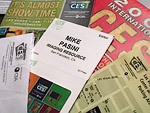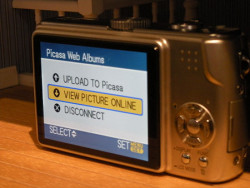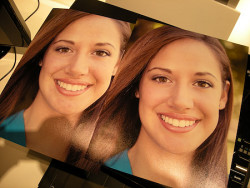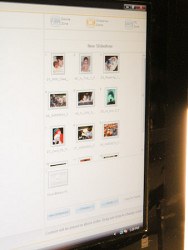MONDAY AT CES
The Sad & Beautiful Show Opens
 By MIKE PASINI
By MIKE PASINIEditor
The Imaging Resource Digital Photography Newsletter
(Apologies for the previously garbled display of this report. We weren't able to post our edits online as Monday night passed into Tuesday morning when we lost Internet service at our Las Vegas hotel. Today's update cleans things up at last.)
LAS VEGAS -- It was a sad and beautiful day, to mangle a quote in a Jim Jarmish movie. The sadness, of course, was learning about the loss of Herbert Keppler (http://www.imaging-resource.com/NEWS/1199694694.html). He made photography better for everyone who clicks a shutter.
|
|
He did it by working with the companies that made the gear he evaluated rather than merely standing on the sidelines wagging his finger. And that sense of cooperation through criticism was much in evident today as the Consumer Electronics Show opened its doors. It even hit home when we visited Nikon.
But that was the beautiful part, as you'll see in today's report.
We've also posted a gallery of images again (http://www.imaging-resource.com/EVENTS/ICES08/ces-reports/mon-gallery/), just to get the ball rolling. The 53 shots from the show floor cover a bit more than we cover here, so read the captions for the details.
Now on the top sightings from today's trek.
We got a peek at Sony's new Alpha A200 dSLR. We did more than peek, though. We managed to sneak a CompactFlash card into it to take a few shots. You can download the full resolution images by clicking on the thumbnails.
Sony is targeting the new dSLR owner just moving up from a digicam with the A200. The company plans to welcome them with some familiar features, while maintaining a focus on easy operability.
So the A200 includes features like Scene modes (Portrait, Landscape, Macro, Sports, Sunset and NightP Portrait/Night View), Creative Styles (Vivid, Portait, Landscape, Night View, Sunset, B&W, Adobe RGB, Standard), anti-dust technology (static-free coating on CCD filter plus vibration), slide show display, HDTV thumbnails, a function guide and Super SteadyShot.
With a 10.2 megapixel CCD sensor, it shoots 3.0 frames a second using a nine-point autofocus system. Available at the end of the month, it lists for $699.
Sony (http://www.sony.com) had some other interesting products, mostly HDTV displays.

OLED TV. Don't even think about it.
We got a glimpse, for example, of the first Organic Light Emitting Diode TV for the U.S. market, available on the Web now, according to one presenter at the booth. They're pretty small and pretty expensive, with the 11-inch model going for $2,500. But the very thin panels offer a million-to-one contrast ratio with very deep blacks, rich color and fine detail. Power consumption is also low, viewing angles wide and motion blur-free.
The company also demonstrated a wireless home setup in which two wireless monitors received signals from a server using the same Near Field Communications technology we discussed in yesterday's Pepcom report (http://www.imaging-resource.com/EVENTS/ICES08/ces-reports/ces-pep.htm). NFC provides short range wireless transfers between devices that do not need to be paired like Bluetooth devices to share information. The simple setup trumps the short range for in-room wireless use.
Want to see what it's like behind the anchor's desk? NBC will broadcast its Nightly News with Brian Williams from the show floor Wednesday evening. We took a picture from the rear of the set so you could imagine yourself announcing peace in the Middle East, say.
NIKON DEFENDS S51C | Back to Contents
We got tackled outside a meeting room by Nikon's Bob Giordano. He had just read our Coolpix S51c review and wanted to talk. We'd just been discussing the very same thing with Nikon's Lindsay Silverman.
Nikon is very excited about their Picturetown online service. The S51c's WiFi capability transmits directly to that service through your own router at home or a T-Mobile hotspot. In our tests, Picturetown performed exactly as advertised. Images were uploaded in tact, email notifications sent and you could download the full resolution images easily.
So what's the problem?
In our review, we said it wasn't enough. A WiFi-capable camera ought to be able to transmit its images through your router to your computer or even just to your WiFi-enabled computer.
Bob suggested the S51c represents a new use of WiFi for people who use cellphones to send photos from T-Mobile hot spots and want to do it with their cameras, too. They don't understand ad hoc networks and firewalls. They don't make backups and they don't even copy the images to their computer or even erase them from the card.
In fact, he correctly pointed out, Panasonic is copying the concept in the WiFi concept camera they announced today.
We suggested local WiFi transfer should be an option. The ability to communicate is what you expect of a wireless device. Those very cellphones at Starbucks can actually communicate with a Bluetooth-enabled laptop or printer, after all. There isn't a hardware compatible device that excludes them.
The problem for any company, though, is supporting a sophisticated protocol like WiFi. Setup isn't as easy as Bluetooth pairing. Building a service like Picturetown on WiFi can't be done in a day, let's say.
And, in fact, earlier Lindsay had acknowledged the topic was open for discussion again.
Beautiful, no?

Concept Camera. Nikon's concept, actually.
PANASONIC WIFI DIGICAM | Back to Contents
So what's this new Panasonic WiFi concept camera? It's so new it doesn't even have a model name, although the company has made arrangements with T-Mobile and Picasa already to support it.
At the show, a TZ3 was outfitted with WiFi capability and live shots at the show were uploaded to Google's site. Once they were on the server, an email could be sent to your friends with a link to the image.
You can also display the online album on the camera and even edit and delete individual images.
It did indeed remind us of the S51c. And Kodak's EasyShare One, too, come to think of it. But that was many shows ago.
KODAK SOFTWARE | Back to Contents
At the Kodak booth (http://www.kodak.com) we saw before and after shots of the company's new facial retouching software shipping with the new compact ESP-3 AiO printer. Skin tone and blemishes were noticeably improved, although the changes were not drastic. Probably just the right touch to sell more paper and ink, we thought.

Retouched. The one on the right is the retouched image.
We also saw the company's new Custom Creations Software, which can build photo books and other merchandise from your EasyShare albums. The software, which resides on your hard disk not Kodak's server, is available now and can be downloaded for free from Kodak's site.
Images are sorted by date and time but they are also grouped by time. But the software goes a step further by doing a little content analysis to tell what images go with each other.

KEDDS. The panels on the right side of the screen are filled with images and music to make slide shows on a Kodak picture frame.
It uses that information to lay out your photo book with from one to five images a page (although it can up to eight if you ask nicely). If you don't like the layout, you can tell it try again or you can do it yourself.
Manually resizing, rotating or moving the images around was simple enough. Icons to the right also let you select another image as your main image. And you can get rid of the background if you don't like it, too.
The background image on the demo template was a ghosted black and white image of the main image. When we changed the main image, the background did not change, but you have the option of updating it if you like.
You can also add text and even clip art, creating not just photo books but scrapbooks, too.
When you're ready to proof your book, the software displays it full screen on your monitor. If you like what you see, the software writes your project to a CD, thumbdrive or memory card, which you take to a retailer to have the project printed on Qualex printers.
Kodak has another software project, not quite ready for prime time, that caught our eye. Officially called Kodak EasyShare Digital Display Software, it resides on your computer to build slide shows from your EasyShare albums which it can then send to a Kodak picture frame.
The slide show creation process is simply. Sort your images in EasyShare first, then drag them to the image pane. You can rearrange them manually there, too. Then select a music file to accompany the slide show by dragging it to the audio pane.
Then you just save the show to the frame or save it to your hard disk. The frame itself handles details like transitions and looping the music, so the presentation is polished by not very flexible.
FORTY MILES | Back to Contents
Our cab driver last night told us another client of his claimed to walk 40 miles a day at CES. We thought you might as well climb something if you were going to go that far. Like Mt. Everest.
Covering CES is a bit like rock climbing. You put you hands and feet in as sure a hold as you can get them as you look over the shiny, slippery new stuff. Does it solve a real problem? Does it work?
We'll chalk our fingertips and give it another try tomorrow.